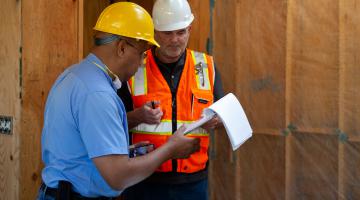California’s buildings produce a quarter of the state’s greenhouse gas (GHG) emissions, making homes and businesses a major contributor to climate change. Taking a variety of actions to reduce GHG emissions is known as decarbonization. There are many steps that building owners and renters, builders, and local governments can take to decarbonize buildings cost-effectively and support transportation electrification.
The information, guidance, and best practices shared here are intended to assist in overcoming barriers to decarbonizing buildings and installing electric vehicle (EV) charging equipment in residential and commercial buildings.
“Decarbonization” relates to activities that reduce GHG emissions, such as reducing or removing fossil gas use in buildings or replacing fossil fuel-generated electricity with renewable electricity from sources like solar or wind (2021 California Building Decarbonization Assessment). California has strong existing policies and ambitious long-term goals to support building and transportation decarbonization.
Decarbonizing buildings includes seven primary strategies:
- Electrification – switching gas appliances and equipment to electric ones.
- Electricity generation decarbonization (also referred to as grid decarbonization) – replacing fossil fuel generated electricity with renewable electricity from sources like solar and wind.
- Energy efficiency – adapting technology to meet consumer needs while using less energy.
- Demand flexibility – shifting electricity use to a different time of day that typically reduces utility bills and GHG emissions.
- Distributed energy resources – using other technologies to power buildings that do not rely on the statewide electricity grid, such as rooftop solar and onsite battery storage systems.
- Refrigerant leakage reduction – preventing refrigeration leakage from existing refrigeration and air-conditioning systems and capturing and properly disposing of refrigerants during system replacement, mostly in commercial and industrial buildings.
- Decarbonizing the gas system – replacing a portion of fossil gas with renewable gas, such as biomethane. Renewable energy sources emit little to no GHGs and can be cheaper.
Decarbonizing transportation includes developing and deploying clean-energy vehicles, sustainable fuels, and other clean-energy technologies, while also building out the supporting infrastructure.
Switching to energy-efficient, electric, or smart appliances will help reduce indoor air pollution caused by burning fossil fuels and reduce operating expenses. CEC building and appliance standards goals are to reduce energy, but in doing so there is significant avoided carbon pollution. In addition to setting minimum standards, the CEC has many programs that help reduce GHG emissions from buildings and transportation.
Building Programs
Building Decarbonization
The CEC plays a pivotal role in developing and administering programs that support building decarbonization efforts. Visit the Building Decarbonization topics page to see a full list of programs.
Transportation Programs
Clean Transportation Program
The Clean Transportation Program (previously known as the Alternative and Renewable Fuel and Vehicle Technology Program) provides funding to support innovation and accelerate the development and deployment of advanced transportation and fuel technologies.
California Electric Vehicle Infrastructure Project (CALeVIP)
CALeVIP provides funding for installing publicly available EV charging stations to support the rapid adoption of electric vehicles across California.
Communities in Charge
Funding for projects designed to transform EV charging accessibility and accelerate the market is available to schools, health care centers, local businesses, and communities, among others.
Vehicle-Grid Integration Program
A CEC effort to improve commercial communication standards between the vehicle and infrastructure such as building, grid services, home, charging stations, and other services that help improve grid reliability and efficiency.
Appliance Programs
Appliance Efficiency Standards
California’s appliance efficiency regulations, combined with federal standards, set minimum energy and water performance levels for a broad range of consumer and commercial devices (including consumer electronics, household appliances, plumbing equipment, and others).
Flexible Demand Standards
California flexible demand appliance standards will reduce GHG emissions by scheduling, shifting, or curtailing appliance operations, with consumer consent, to times when electricity sources produce low or no carbon.
- Informational Building and Home Energy Resource Hub docket #22-DECARB-02.
- Assembly Bill 3232 and the California Building Decarbonization Assessment - PDF
- 2021 IEPR Volume I: Building Decarbonization
Senate Bill 68 (Becker, Chapter 720, Statutes of 2021) directed the CEC to gather and develop guidance and best practices to overcome barriers to decarbonizing buildings and installing electric vehicle charging equipment. This web page implements the requirements of that bill to help building owners, the construction industry, and local governments.
Senate Bill 68: Building Electrification and Electric Vehicle Charging



